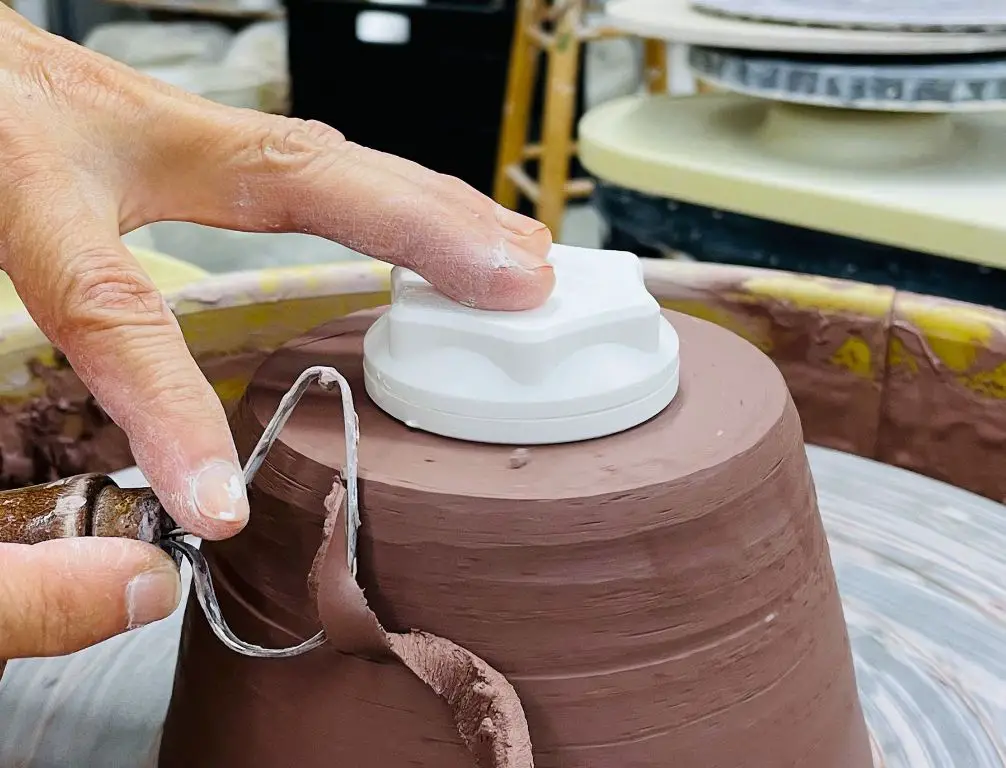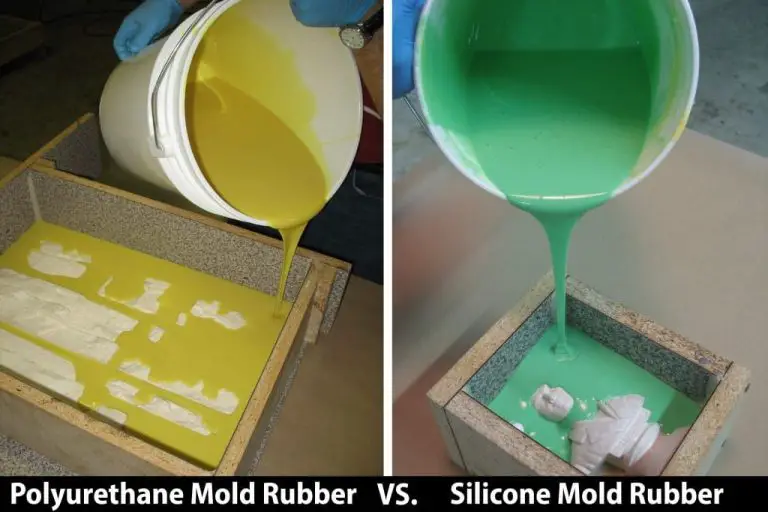What Is A Pottery Trimming Spinner?
What is Pottery Trimming?
Pottery trimming is the process of refining the shape and finish of pottery pieces after they have been formed on the potter’s wheel and allowed to partially dry. It is an important secondary stage in the creation of ceramic wares like bowls, cups, vases, and plates.
Trimming serves several purposes in pottery making. It allows the potter to remove excess clay and refine the shape and symmetry of a thrown piece. Trimming smooths the bottom and creates a neat, finished foot on the base of an item. It also thins walls to an even thickness and creates sharper angles and details not possible when a piece is originally thrown. The trimming process gives the potter greater control and precision in the final form.
Trimming is done on the pottery wheel just like throwing. A leather-hard piece that has dried slightly after being shaped is placed on a special trimming wheel or bat attached to the wheel head. Using various metal scraping and cutting tools, the potter then removes excess clay and perfects the details of the piece.
Trimming transforms the rough, uneven form created when a piece is thrown on the wheel into a precisely shaped, finished ceramic object ready for decorating and firing. It is usually an indispensable step in making refined, high-quality pottery.
Trimming Wheels and Spinners
A trimming wheel, also called a trimming spinner or potter’s wheel, is a device used to rotate pottery while trimming and shaping it. The wheel enables potters to smoothly shape and refine the form and surface of pottery pieces after the clay has partially dried. Trimming wheels allow pottery to be precisely rotated at a consistent speed, which gives the potter more control during the trimming process.
There are a few main types of trimming wheels:
- Electric pottery wheels – These have an electric motor to spin the wheel head. Speed is controlled via a foot pedal or knob. They provide consistent rotational force and speed.
- Kick wheels – The wheel head is spun manually by kicking a lever. Speed is variable based on how quickly the potter kicks. These are more portable and do not require electricity.
- Treadle wheels – The wheel head is turned using a foot treadle that is pumped like a pedal. Treadle wheels tend to be somewhere between electric and kick wheels in consistency and control.
- Hand-cranked wheels – A hand crank is turned to spin the wheel. These offer the least rotational force and can be tricky for trimming.

Trimming wheels need to have a solidly attached, smoothly rotating head to properly support and turn pottery during precise trimming work (Source 1). Etric wheels tend to be most popular for regular trimming since their consistent, high-powered rotation allows greater control and efficiency.
Parts of a Pottery Wheelhead
The wheelhead is the circular rotating platform that sits atop the pottery wheel. It is the surface that the clay rests on while being thrown or trimmed. The main parts of a wheelhead include:
- Head – The circular platter or wheelhead that spins. It is usually made of plaster, plastic, concrete, or metal.
- Splash pan – A rim around the wheelhead that catches dripping water and flying clay bits.
- Bearing system – Ball bearings or other mechanisms that allow the wheelhead to spin smoothly and evenly.
- Motor – Provides power to spin the wheelhead, often with variable speed controls.
The wheelhead attaches to the motor housing and bearing assembly below. Quality wheelheads are perfectly balanced and turn true without wobbling. The material affects grip and sticking when working with clay. Plaster tends to provide the best grip. Wheelheads may be solid or hollow with open centers for accessing the clay from below.
Using a Trimming Spinner
A trimming spinner allows you to refine and perfect the shape of pottery after it has been thrown on the wheel. Here are some tips for using a trimming spinner effectively:
Secure the pottery firmly to the wheelhead using clay bats or plaster batts before trimming. This prevents the piece from shifting while you trim. According to Lakeside Pottery’s trimming tutorial, tool position should start around the 3 o’clock position on the wheel for optimal control and leverage.
Use specialized trimming tools like metal loop tools, wooden ribs, and metal kidney tools to refine the shape and smooth the surfaces. Trimming is often done at a faster wheel speed than throwing. Rotate the wheel clockwise as you trim using light, precise movements. Avoid taking off too much clay at once.
Pay attention to the direction you trim in. Trimming downward removes more clay, while trimming upward refines the shape. Use a light touch and trim patiently for best results. Trimming takes practice, but allows for incredible control over the final form.
Trimming Techniques
Trimming techniques refer to the various methods potters use when cutting, shaping, and smoothing clay on the pottery wheel. Proper trimming requires practice and skill to create smooth, symmetric forms.
When trimming, it’s important to keep the clay centered on the wheel. Apply gentle pressure with the trimming tools against the spinning clay to gradually cut away excess material. Work methodically around the form, shaving off sections little by little.Cut into the outside mark of the foot, removing clay from the outside of the foot down to where the wall starts to thicken.
Use a rounded kidney tool to smooth the clay surface. Careful trimming and smoothing will create clean lines and refined symmetry. A metal rib can also be used to further compress and smooth the surface texture. When shaping with trimming tools, work at an angle instead of straight into the clay to avoid ripping the surface.
Maintaining proper wheel speed, hand positions, tool angles, and centering are all important skills to develop for trimming pottery successfully. With practice over time, muscle memory will make trimming feel more intuitive and precise.
Common Trimming Tools
Trimming a pot requires a few basic tools including the kidney tool, ribbon tool, and metal rib. The kidney tool is shaped like a kidney and has curved edges that allow potters to smooth curves and hard-to-reach areas on a pot. The ribbon tool has a thin, flat blade that can slice and trim excess clay. It’s useful for detailing and cutting decorative lines. The metal rib looks like a flat piece of metal or plastic that can compress clay and smooth surfaces. It’s available in various widths. These essential trimming tools help shape pots, even out surfaces, refine forms, and add decorative elements.
Some other common trimming tools are loop tools for scraping, texture tools like serrated ribs, and angled trimming tools. Most are made from stainless steel or plastic. Quality and sharpness are important when selecting trimming tools. Top brands known for excellent pottery trimming tools include Bailey, Dolan, Kemper, and Shinwa. Many trimming tools come in sets or can be purchased individually depending on needs. With practice using basic trimming tools, potters can trim most forms and refine details.
Advanced Trimming Methods
Once potters have mastered basic trimming techniques, they can move on to more advanced methods like undercutting and beveling rims to add sophistication to their pieces.
Undercutting involves removing clay from the interior base of a thrown pot to reduce weight and create an elegant profile. This is done using arecurved trimming tool or loop tool. Undercuts create shadows and visual interest on the interior of a piece. Proper technique involves holding the tool at a 45 degree angle and carefully scraping out clay while rotating the wheel.
Beveling rims refers to angling the top lip of a pot inward or outward to create a slanted surface. An inward bevel adds a delicate finish to wheel-thrown pieces, while an outward bevel can accentuate the form. Beveling requires a steady hand and is achieved with a metal rib or beveling tool. Too much pressure can cause cracks or collapses.
Master potters also use double beveling, faceting, and other combinations of angled surfaces to produce dynamic effects on their finished wares. Consistent results require patience, precision, and practice with these more advanced trimming techniques.
Trimming Safety
Proper trimming technique and safety practices are crucial when working on a pottery wheel. Trimming tools and the spinning wheel can pose hazards if not used correctly.
It’s important to keep the wheel moving at an appropriate speed – too fast can cause clay to fly off, while too slow makes trimming more difficult. The typical speed for trimming is around 120 rpm. Always start slowly and increase speed gradually as you get a feel for the clay’s stability.
Position hands carefully when trimming. Keep fingers together and tucked under to avoid getting them caught between the tool and clay. Avoid placing hands in the path of rotation. Take breaks regularly to give hands a rest.
Select trimming tools that allow a comfortable grip and safe clearance between fingers and clay. Hold tools securely but not too tightly. Always cut down and away from hands. Don’t force tools through clay, let the turning do the work.
Wear safety glasses to protect eyes from flying clay particles. An N95 mask can reduce ingestion of silica dust. Clean tools, wheel, and work area after each trimming session to maintain a safe working environment.
For more on pottery wheel safety, see the BU Reminder on Pottery Wheel Hazards and Ceramic School’s Studio Safety Guide.
Troubleshooting Trimming Issues
Trimming pottery can be tricky at first, but with practice it gets easier. Common issues that arise during trimming include warped pots, uneven surfaces, and difficulty controlling the clay. Here are some tips for troubleshooting and fixing trimming problems:
If your pots are coming out lopsided or warped, the clay may have dried out too much before trimming. Try wedging your clay again before throwing to ensure even moisture distribution. Also make sure to trim pots soon after throwing, within an hour or two, before they stiffen up. Wrapping pots in plastic after throwing helps delay drying.[1]
Uneven trimming often results from inconsistent wheel speed or pressure on the cutting tool. Maintain a steady wheel speed and keep your trimming tools at a consistent angle as you refine the shape. Use a light touch, allowing the tool to slice the clay rather than gouging it out. Building up thick walls can also make trim jobs harder. Try throwing thinner pots initially.
If you struggle with controlling the clay while trimming, the issue may be too much water content. Let the pot firm up more before trimming, or try a drier clay recipe. Sharp trimming tools will also cut through wet clay more easily than dull ones. Hone your tools regularly for best results.
With practice and patience, trimming problems can be overcome. Adjust your process and tools as needed until you achieve smooth results. Consistency and the right moisture level are key for trimming success.
Innovations in Trimming Technology
The pottery wheel has come a long way since its first use thousands of years ago. Modern innovations are making trimming easier and more ergonomic than ever before.
New trimming wheels like the DiamondCore GT Revolution Wheel feature high torque motors and variable speed control for power and precision during trimming. Some even have foot pedals to free up the potter’s hands. Adjustable wheelheads provide the ideal trimming angle and reduce strain.
Advances in trimming tool design focus on comfort and control. Ergonomic handles reduce hand fatigue. Lightweight materials make tools easier to wield. Features like swiveling blade holders give the potter flexibility and leverage.
Attachments for trimming wheels add functionality. Water attachments keep clay wet and tools clean. Digital readout displays provide exact rpm measurements. LED lighting illuminates the trimming area. Cameras can assist with trimming at precise angles. Dust collection systems keep airborne clay to a minimum.
While the fundamentals of trimming remain the same, new technologies make the process smoother, more customizable, and less physically taxing for potters.


